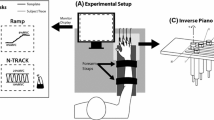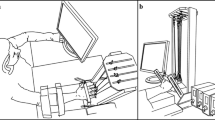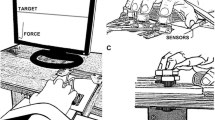Abstract.
The framework of the uncontrolled manifold hypothesis (UCM hypothesis) was applied to the analysis of the structure of finger force variability during oscillatory force production tasks. Subjects produced cycles of force with one, two (index and middle), or three (index, middle, and ring) fingers acting in parallel against force sensors mounted inside a small frame. The frame could be placed on the top of a table (stable conditions) or on a 4-mm-wide supporting surface (unstable conditions). Subjects were less variable when they used two fingers than when using one finger; adding the third finger did not change indices of variability of the performance. Components of finger force variance that did (VUN) or did not (VCOMP) change the value of a particular functional variable were computed for two control hypotheses: (1) at each time, the subjects tried to stabilize the total value of force (force-control); and (2), at each time, the subjects tried to stabilize the total moment produced with respect to an axis parallel to the hand/forearm (moment-control). Most subjects showed selective stabilization of moment and destabilization of force throughout most of the force cycle, in both stable and unstable conditions. The shapes of VUN and VCOMP suggested a possibility of selective compensation of timing errors across fingers within force cycles. One subject showed different relations between VUN and VCOMP, suggesting that these relations did in fact reflect particular central strategies of solving the tasks. The UCM method is applicable to force production tasks. It allows the comparison of control hypotheses in a quantitative way and unveils central strategies of control of redundant motor systems. Within this approach, redundancy (rather, abundance) is not a problem but an inherent part of a solution for natural motor tasks.
Similar content being viewed by others
Author information
Authors and Affiliations
Additional information
Electronic Publication
Rights and permissions
About this article
Cite this article
Latash, M.L., Scholz, J.F., Danion, F. et al. Structure of motor variability in marginally redundant multifinger force production tasks. Exp Brain Res 141, 153–165 (2001). https://doi.org/10.1007/s002210100861
Received:
Accepted:
Issue Date:
DOI: https://doi.org/10.1007/s002210100861




